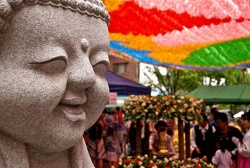Difference between revisions of "Dhamma vicaya"
| (One intermediate revision by the same user not shown) | |||
| Line 4: | Line 4: | ||
==History== | ==History== | ||
| − | In the [[Pali canon]]'s [[Sutta Pitaka]], this is the second of the [[Seven Factors of Enlightenment]] ([[satta bojjhaṅgā]]). It is preceded by the establishment of [[mindfulness]] ([[sati]]) and leads to [[energy]] ([[viriya]]), [[rapture]] ([[piti]]), {{Wiki|tranquillity}} ([[passaddhi]]), [[concentration]] ([[samadhi]]) and [[equanimity]] ([[upekkha]]). According to the [[Samyutta Nikaya]], this factor is to be developed by paying continuous careful [[attention]] ([[yoniso manasikāra bahulīkāro]]) to the following states ([[dhammā]]): [[wholesome]] and [[unwholesome]] ([[kusalā-akusalā]]); [[blameable]] and [[blameless]] ([[sāvajjā-anavajjā]]); inferior and superior ([[hīna-paṇītā]]); and, [[evil]] and good ([[kaṇha-sukka]]). An alternate explanation in the [[nikayas]] is that this factor is aroused by "discriminating that [[Dhamma]] with [[wisdom]]" ([[taṃ dhammaṃ paññāya pavicināti]]). | + | In the [[Pali canon]]'s [[Sutta Pitaka]], this is the second of the [[Seven Factors of Enlightenment]] ([[satta bojjhaṅgā]]). It is preceded by the establishment of [[mindfulness]] ([[sati]]) and leads to [[energy]] ([[viriya]]), [[rapture]] ([[piti]]), {{Wiki|tranquillity}} ([[passaddhi]]), [[concentration]] ([[samadhi]]) and [[equanimity]] ([[upekkha]]). According to the [[Samyutta Nikaya]], this factor is to be developed by paying continuous careful [[attention]] ([[yoniso manasikāra bahulīkāro]]) to the following states ([[dhammā]]): [[wholesome]] and [[unwholesome]] ([[kusalā-akusalā]]); [[blameable]] and [[blameless]] ([[sāvajjā-anavajjā]]); {{Wiki|inferior}} and {{Wiki|superior}} ([[hīna-paṇītā]]); and, [[evil]] and good ([[kaṇha-sukka]]). An alternate explanation in the [[nikayas]] is that this factor is aroused by "discriminating that [[Dhamma]] with [[wisdom]]" ([[taṃ dhammaṃ paññāya pavicināti]]). |
The [[Abhidhamma]]'s [[Dhammasaṅgaṇi]] even more strongly associates [[dhamma vicaya]] with [[paññā]] ([[wisdom]]) in its enumeraton of [[wholesome]] states ([[kusalā dhammā]]): | The [[Abhidhamma]]'s [[Dhammasaṅgaṇi]] even more strongly associates [[dhamma vicaya]] with [[paññā]] ([[wisdom]]) in its enumeraton of [[wholesome]] states ([[kusalā dhammā]]): | ||
| − | : What on that occasion is the faculty of [[wisdom]] ([[paññindriyaṃ]])? | + | : What on that [[occasion]] is the {{Wiki|faculty}} of [[wisdom]] ([[paññindriyaṃ]])? |
| − | : The [[wisdom]] which there is on that occasion is understanding, search, research, searching the [[Truth]].... | + | : The [[wisdom]] which there is on that [[occasion]] is [[understanding]], search, research, searching the [[Truth]].... |
| − | where "searching the [[Truth]]" is C.A.F. Rhys Davids' translation of [[dhammavicayo]]. | + | where "searching the [[Truth]]" is C.A.F. {{Wiki|Rhys Davids}}' translation of [[dhammavicayo]]. |
In later [[Abhidhamma]] texts and in post-canonical {{Wiki|literature}} (such as those by the 4th c. CE [[Indian]] [[scholar]] [[Vasubandhu]]), [[dhamma vicaya]] refers to the study of [[dhamma]] as [[physical]] or [[mental]] [[phenomena]] that constitute [[absolute]] {{Wiki|reality}} ([[Pali]]: [[paramattha]]; Skt.: [[paramārtha]]) | In later [[Abhidhamma]] texts and in post-canonical {{Wiki|literature}} (such as those by the 4th c. CE [[Indian]] [[scholar]] [[Vasubandhu]]), [[dhamma vicaya]] refers to the study of [[dhamma]] as [[physical]] or [[mental]] [[phenomena]] that constitute [[absolute]] {{Wiki|reality}} ([[Pali]]: [[paramattha]]; Skt.: [[paramārtha]]) | ||
Latest revision as of 10:26, 9 March 2015
In Buddhism, dhamma vicaya (Pali; Sanskrit: Dharma-vicaya) has been variously translated as the "analysis of qualities," "discrimination of dhammas," "discrimination of states," "investigation of doctrine," and "searching the Truth." This concept implies applying discernment to things in order to deliver one from ignorance and craving.
History
In the Pali canon's Sutta Pitaka, this is the second of the Seven Factors of Enlightenment (satta bojjhaṅgā). It is preceded by the establishment of mindfulness (sati) and leads to energy (viriya), rapture (piti), tranquillity (passaddhi), concentration (samadhi) and equanimity (upekkha). According to the Samyutta Nikaya, this factor is to be developed by paying continuous careful attention (yoniso manasikāra bahulīkāro) to the following states (dhammā): wholesome and unwholesome (kusalā-akusalā); blameable and blameless (sāvajjā-anavajjā); inferior and superior (hīna-paṇītā); and, evil and good (kaṇha-sukka). An alternate explanation in the nikayas is that this factor is aroused by "discriminating that Dhamma with wisdom" (taṃ dhammaṃ paññāya pavicināti).
The Abhidhamma's Dhammasaṅgaṇi even more strongly associates dhamma vicaya with paññā (wisdom) in its enumeraton of wholesome states (kusalā dhammā):
- What on that occasion is the faculty of wisdom (paññindriyaṃ)?
- The wisdom which there is on that occasion is understanding, search, research, searching the Truth....
where "searching the Truth" is C.A.F. Rhys Davids' translation of dhammavicayo.
In later Abhidhamma texts and in post-canonical literature (such as those by the 4th c. CE Indian scholar Vasubandhu), dhamma vicaya refers to the study of dhamma as physical or mental phenomena that constitute absolute reality (Pali: paramattha; Skt.: paramārtha)
